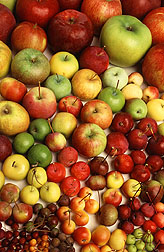This page has been archived and is being provided for reference purposes only. The page is no longer being updated, and therefore, links on the page may be invalid.
|
|
|
|
Geneva Station Celebrates 125th Anniversary
By Ann PerrySeptember 14, 2007
The New York State Agricultural Experiment Station (NYSAES), located on Cornell University's campus in Geneva, opened its doors in 1882. This year the NYSAES is having a year-long celebration of its 125th anniversary, and the Agricultural Research Service (ARS), which opened a laboratory in Geneva in 1953 using land and facilities leased from Cornell, is joining in.
ARS scientists at Geneva—who regularly collaborate with NYSAES scientists—conduct research on apples, grapes and a range of vegetables. In cooperation with the NYSAES and the State Agricultural Experiment Stations of the other Northeastern states, they also maintain one of more than 20 genebanks in the National Plant Germplasm System. The Geneva genebank safeguards more than 20,000 plant samples, or accessions. Almost 7,000 apple accessions are part of this vast collection, including seedlings of wild apple species from central Asia, where the progenitors of apples first took root.
On Sept. 14, about a thousand 9th and 10th grade students will tour ARS laboratories, where they can see for themselves the challenges and promises that a scientific career presents. On Sept. 15, both NYSAES and ARS facilities and fields will be open for tours and demonstrations.
What can visitors see? For starters, there are wild apple seedlings from Kazakhstan. There is the 260-member apple "core" collection containing trees from seeds collected in Europe and Asia, as well as modern and heirloom cultivars. An apple rootstock program will show how apples are grown on dwarf rootstocks.
Grape vineyards are bursting with cold-hardy, disease-resistant fruit. Fields where ARS scientists grow out germplasm collections flourish with tomatoes, onions, celery and other vegetables. Visitors will be able to sample some of the fruits and vegetables and compare the difference in taste between current varieties and their venerable ancestors.
Information stations will also include DNA extractions, pollination demonstrations and a transparent beehive for observing the day-to-day routines in a working bee colony.
ARS is the U.S. Department of Agriculture's chief scientific research agency.

